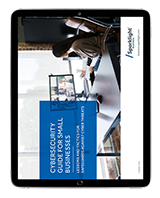
Cybersecurity Best Practices for Your Small Business
Over half of small businesses think they’re too small of a target for cybercriminals to bother with. But the reality is just the opposite—43% of all cyberattacks are against small businesses. They have valuable assets and criminals don’t have to breach the sophisticated security systems larger businesses have. The good news is there are steps you can take now to make your business less of a target. Start with these cybersecurity best practices for small businesses.
Raise The Drawbridge
There was a reason medieval castles had a moat and a drawbridge. They established a protective perimeter around the property. The equivalent of that in the cyber world is a firewall. It keeps marauders from invading your fortress. Most operating systems have one so make sure you’ve enabled yours.
In addition, consider these steps to make it harder to storm your castle:
- Install antivirus software and keep it updated. It can alert you when someone is trying to break in so you can take action.
- Use a Virtual Private Network (VPN) to encrypt information going in and out of the business. Attackers don’t speak this language so they move on.
- Take advantage of multifactor authentication. This adds another layer beyond a password before you are permitted to enter a network or program. It might be a one-time code texted to you. Here’s how to set one up on many of the programs you use.
Deputize Your Staff
It isn’t always a malicious outsider who causes a security breach. In fact, 41% are the result of human error—from you or one of your employees. Maybe you clicked on an email link you thought was from a supplier. Or an employee used “password” as their login. That’s why it’s important to deputize them with information to avoid an accidental break.
Here are some free training resources to arm you and your employees:
- Cybersecurity for Small Business – This 30-minute online class from the Small Business Administration (SBA) identifies common threats and how to guard against them.
- What Small Businesses Need to Know About Cybersecurity – SCORE offers this webinar with information on today’s threats and how to protect your business.
- Stop. Think. Connect – The Department of Homeland Security offers brochures and posters to remind employees to be on the lookout.
Call for Backup
Even with the best of security measures, there’s still a chance your business could be the victim of a cyberattack. So put procedures in place to make it easier to recover. One of the easiest is to regularly back up copies of important business data and information. If you’re hacked, the backup can quickly get you up and running again.
Your backup might include financial files such as accounts receivable/payable, human resource data and customer databases. You can back up using a local hard drive or a cloud-based software. Small Business Trends reviewed these backup software options.
Consider automating your backups by scheduling them in your system. Doing so eliminates the possibility of forgetting it. It is also recommended to store your backup in different locations—locally and remotely.
Cybertheft has become an unfortunate reality for small businesses. But following best practices like these can help to secure your business assets.
The trends, insights, and solutions you need to grow your business.
By signing up, you’re subscribing to our monthly email newsletter, The
Wire. You may unsubscribe at any time.
Your information stays safe with us. Learn more about our privacy
policy.











![[#MSP_NAME#] Logo](/themes/sparklight_business/images/transition-logos/migration-banner-logo-[#MSP_CD#].png)
